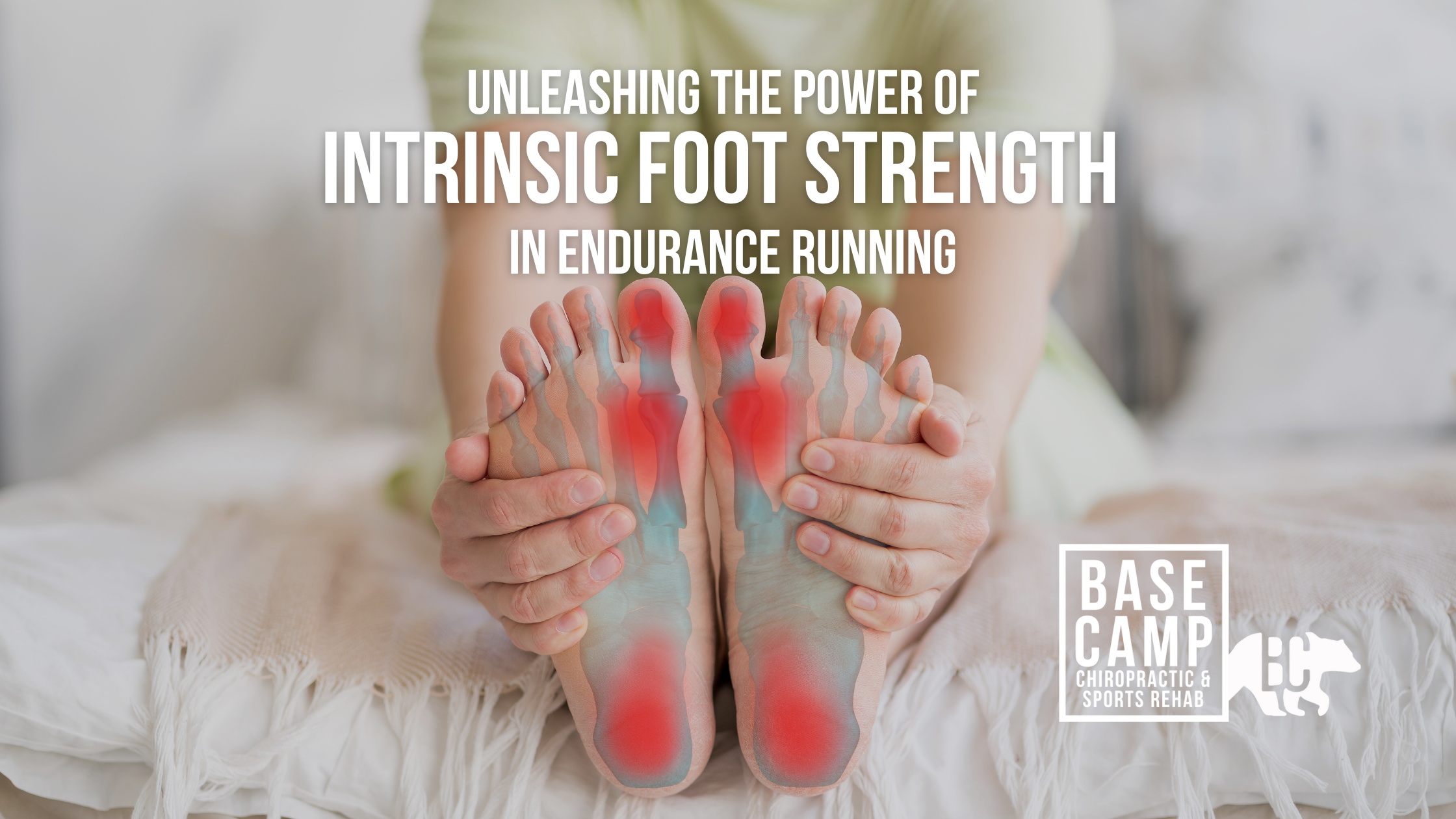
Blog
want to take a crack at your injuries from home?
Check out our blog posts and find the topics specific to you
Topics:
Unleashing the Power of Intrinsic Foot Strength in Endurance Running
In the world of running, where every stride adds up and the body keeps score, the significance of intrinsic foot strength often goes unnoticed until it can’t be ignored. While many runners focus extensively on building leg strength, improving cardiovascular endurance, and perfecting their running form, the role of the feet tends to be overlooked. However, understanding and harnessing the power of intrinsic foot strength can be a game-changer for endurance athletes, enabling them to run longer, faster, and with reduced risk of injury.
Introduction:
In the world of running, where every stride adds up and the body keeps score, the significance of intrinsic foot strength often goes unnoticed until it can’t be ignored. While many runners focus extensively on building leg strength, improving cardiovascular endurance, and perfecting their running form, the role of the feet tends to be overlooked. However, understanding and harnessing the power of intrinsic foot strength can be a game-changer for endurance athletes, enabling them to run longer, faster, and with reduced risk of injury.
What is Intrinsic Foot Strength?
Intrinsic foot strength refers to the strength and stability of the muscles within the foot itself. These muscles play a crucial role in maintaining proper foot mechanics, providing support, absorbing shock, and facilitating efficient propulsion during running.
Why is it Important for Endurance Runners?
Endurance running places significant demands on the feet, as they repeatedly absorb the impact of each stride over long distances. Weakness or instability in the intrinsic foot muscles can lead to various pain patterns, including plantar fasciitis, shin splints, and bone stress injuries. By developing strong and resilient feet, endurance runners can enhance their performance while reducing the risk of common overuse injuries.
Benefits of Strong Intrinsic Foot Muscles:
1. Enhanced Stability: Strong intrinsic foot muscles contribute to better foot stability, allowing runners to maintain proper alignment and balance, especially on uneven terrain.
2. Improved Propulsion: A strong arch provides a solid platform for pushing off the ground with greater force, resulting in more powerful strides and increased speed.
3. Injury Prevention: By distributing forces more evenly throughout the foot, strong intrinsic muscles help reduce the risk of overuse injuries caused by excessive stress on specific areas.
4. Efficient Energy Transfer: Proper foot mechanics supported by strong intrinsic muscles optimize energy transfer from the ground to forward motion, conserving energy and delaying fatigue during long runs.
How to Develop Intrinsic Foot Strength:
1. Barefoot Exercises: Performing exercises barefoot, such as toe scrunches, arch lifts, and towel curls, can target and strengthen the intrinsic foot muscles.
2. Minimalist Footwear: Transitioning to minimalist or barefoot-style shoes encourages natural foot movement and strengthens the muscles by providing less cushioning and support.
3. Foot Strengthening Tools: Using tools like resistance bands, balance boards, or specialized foot strengthening devices can further challenge the muscles and improve their strength and endurance.
4. Gradual Progression: It's essential to progress gradually when training the intrinsic foot muscles to avoid overuse injuries. Start with low-intensity exercises and gradually increase the duration and intensity over time.
Incorporating Intrinsic Foot Training into Your Routine:
Integrating exercises to strengthen intrinsic foot muscles into your regular training regimen can significantly benefit endurance runners. Whether you're a seasoned athlete or just starting your running journey, prioritizing foot strength can lead to better performance, fewer injuries, and a more enjoyable running season.
Conclusion:
Building strong intrinsic foot muscles is not only essential for injury prevention but also for maximizing performance potential. By paying attention to the foundation of their stride, runners can unlock new levels of strength, endurance, and resilience on the road or trail. So, lace up your shoes, strengthen those feet, and embrace the transformative power of intrinsic foot strength in your endurance running journey.
Get Back Out There!
-Dr. Sam
Shin splints- how to tell if you have them and what to do about them
The typical progression for a new runner (or an experienced runner getting back into the seasons) goes something like this:
You finally muster up the energy to get it done. For the past 3 weeks you have been crushing it. You haven’t missed a day, and now you are really finding your groove. You might actually be starting to understand why people LIKE running!?! You started at less than 5 miles per week, but now you are up to 25 miles this week!
Then it happens…
The typical progression for a new runner (or an experienced runner getting back into the seasons) goes something like this:
You finally muster up the energy to get it done. For the past 3 weeks, you have been crushing it. You haven’t missed a day, and now you are really finding your groove. You might actually be starting to understand why people LIKE running!?! You started at less than 5 miles per week, but now you are up to 25 miles this week!
Then it happens. You are supposed to run 6 miles today, to round out your fourth week, but 30 minutes in your shins start to hurt. It’s a new pain… both shins on the inside of the bone (close to your midline). So you slow down and walk for a minute. The pain gets a bit better, but it is still bugging you. So you totally stop for a minute. It feels a whole lot better. You think to yourself ‘...must just be warming up’ so you get back in gear but then 100 feet later it starts again.
What the HECK?
What is going on? Why did this pain start all of a sudden?
But then you remember… your friend told you about this. Oh no. They had to stop running altogether. Is this the end of your running career?
At this point you start Googling and come across a runners forum in which they are talking about EXACTLY the same things that you have. SHIN SPLINTS!
Aka the Runner’s Plague (Ok, fine, that might be my own embellishment).
Shin Splints should not be taken lightly, and there is a reason for it. Also known as Medial Tibial Stress Syndrome (fancy doctor words), Shin Splints are on the spectrum of stress fracture (BROKEN BONE) and should be taken seriously.
What are Shin Splints?
Definition: Shin Splints are the common lingo for an injury called Medial Tibial Stress Syndrome, which is an early indicator of bone inflammation and irritation. If left untreated and unmanaged, Shin Splints can progress to a stress fracture (a really small break in the outer layer of the shin bone).
Anatomy involved: Shin Splints primarily involve your shin bone (the Tibia) and the muscles that control your ankle and foot. (For the nerds, these muscles are the Soleus, Tibialis Posterior and Flexor Digitorum Longus).
How do I know if I have Shin Splints?
Shin Splints are diagnosed in a clinic using a two-step process
History
Physical Exam
If you are experiencing shin pain from running, the first thing that a Chiropractor in Vernon, BC will do will be to ask you questions about your symptoms, running volume, and lifestyle. Based on your answers, that helps your clinician decide what to check during a physical exam.
Shin Splints often shows up the same way:
A runner increases the amount they are running too quickly (e.g. a jump of 10 miles in one week), which results in pain along the midline side of the shin (usually about 5cm long) that gets worse with activity (like running or sometimes even standing) and better with rest.
The symptoms we use to diagnoses Shin Splints are:
Pain along the inside of the shin (usually about 5cm in length, sometimes on both legs)
Pain that increases with activity, but subsides with ‘rest’ (we will talk about what ‘rest’ actually means later)
Pain that is reproduced when we press on the muscle or bone
Some people are more susceptible to shin splints than others. One of the real bummers about shin splints is that if you have had shin splints before, you are more likely to get them again, which makes it that much more important to take seriously. Other factors are things like higher body mass index (a measure of weight to height ratio), foot arch height/control, ankle and hip range of motion, and your vitamin D levels.
The diagnosis of Shin Splints is what we call a ‘Diagnosis of Exclusion’. This means that if you have the history and symptoms that match Shin Splints, as clinicians our primary goal is to make sure it is not something WORSE (e.g. fracture, compartment syndromes, infection, etc). Because of this, it can be hard for you to diagnose shin splints yourself from home, so I highly recommend you seek out a chiropractor, athletic therapist, or physical therapist in Vernon to help you. That said, if you have the symptoms described above and ONLY those symptoms, there is a good chance you have Shin Splints.
How do you treat Shin Splints?
There are multiple ways that a Vernon Chiropractor or Physical Therapist might treat Shin Splints, along with some things you can do from home
The first line of treatment to combat Shin Splints is to manage and eliminate the cause. While every runner is different, the route cause of Shin Splints is VOLUME MANAGEMENT. This means managing how quickly you progress your running volume and making sure you let the tissues rest and ultimately heal. No runner likes to hear the four-letter word... ‘Rest’ is almost as bad as the words ‘surgery’ or ‘cut-the-limb-off’, to some runners. BUT, in this case, we are talking about ‘Relative Rest’. This does not mean complete inactivity. The goal here is to limit the running volume to a frequency and duration you can recover from, but that does not always mean eliminating it all together. Together with your clinician, you can work out how much to run, what kind of surfaces you are running on, different running tempo, alternative footwear, all of which can fall into the intervention of Relative Rest. When in doubt, cut your running volume by 25% for a couple of weeks and see how your body responds.
Once we have a handle on managing Relative Rest, we can talk about the rest. Everything else is supplemental but together can make a difference. A good clinician will help you get out of pain. A GREAT clinician will help you manage your symptoms and keep them from coming back.
Here are a few things we work on when it comes to Shin Splints:
Increasing ankle range of motion and shin strength using exercise
Calming down inflamed tissue with the combination of things like mobility drills, soft tissue therapies, nutritional interventions and joint adjustments
Orthotics for short term symptom relief
Improving your biomechanics to increase your capacity for load and running
Vitamin D supplementation to improve bone health, healing, and inflammation
Do I need an X-ray?
The short answer to the question “Do I need an X-ray for Shin Splints” is No. However, if your clinician thinks that your condition may have progressed beyond a simple bone inflammation to the point of Stress Fracture, they may order imaging. The problem with Shin Splints is that the condition they lead to is called a “Stress Fracture” which is a tiny “hairline” fracture that is almost impossible to see on an X-ray until the injury is healing. The good news is though, even if your injury has progressed to a stress fracture, most runners fully heal. The bad news? It takes time.
If you are unsure if you need an X-ray, or you suspect that you have a fracture, give us a call at Base Camp Sport and Spine or book an appointment for an assessment.
Do I have to stop running?
This is the hardest part of the conversation with an active runner.
Before I get into the nuances of the question of “Do I have to stop running if I have Shin Splints?” we need to set the stage. When it comes to people walking through the door into my clinic or scheduling online coaching/consulting with me my goal is ALWAYS to help you keep you DOING WHAT YOU LOVE and not take you away from it. You already know that if something hurts to do and you stop doing that thing you will have less pain. That is not why you need some guidance. You are looking for solutions to keep you doing what you love. Very rarely (in fact, almost NEVER) do I recommend my patients to completely eliminate their favourite activity. In the rare cases that I do, the elimination is TEMPORARY and only if it is absolutely necessary.
Here are a few considerations when we are considering what to do if you have Shin Splints:
How much are you currently running compared to how much you were running 6 weeks ago?
Rapid changes in mileage?
Changes to your routine?
Why are you running in the first place?
Running only for fitness?
Running in preparation for a race?
Running to clear your headspace?
What does ‘relative rest’ mean to you?
Complete elimination of activity?
Alternate activities besides running?
Changing your running volume/terrain/cadence/pace?
If you have been suffering from Shin Splints, you already know how frustrating they are. The good news is that THEY DO HEAL. The catch is that it takes direction and a structured recovery program. My goal as a clinician is to keep you running. The reality is that Shin Splints do need Relative Rest. This will inevitably mean a change in your running schedule, but it does not mean the complete elimination of your favourite activity.
So… What do I do if I have Shin Splints?
The first thing you should do if you have Shin Splints is to drop your running/activity volume. If you are not getting significant relief within a couple of weeks, the next step is to search out a qualified Chiropractor, Physical Therapist or Athletic Therapist in Vernon to put you through an assessment and build a recovery plan. If you are outside of Vernon, send me a message and I will help connect you with a clinician in your area. Your clinician will help you decide how to proceed and whether or not you need X-rays or an MRI.
First Things to Try (Weeks 1-4):
Relative rest (decreasing your running volume)
Replace some running with other low impact cardio (e.g. bike, swim, row)
Additional things you can start doing from home:
Foot stretching and strengthening
Hip stretching and strengthening
Consider a Vitamin D supplement (almost everyone in North America is Vitamin D deficient. If you are considering taking a Vitamin D supplement, check with your doctor).
Ice massage can be helpful for managing your pain
Exercises for Shin Splints
Hip strength, mobility, and coordination exercises
How long do Shin Splints take to heal?
Brace yourself. It is not going to be an answer you want to hear.
If you do nothing about it and continue to train the way you have been, the most likely outcome is that they will never heal and you will progress to a Stress Fracture.
If you do something about it? Shin Splints can take anywhere from 3-12 months to heal.
This is why Shin Splints recovery can be even more challenging mentally than it is mentally. This is why it is so helpful to have someone to coach you through your recovery.
How long you take to heal is dependent on a few things:
How long you have had symptoms before doing anything about them
Severity of your symptoms and tissue damage
How committed you are to healing and following the proper rehab exercises and protocols
Your overall health
Ready to get rid of your shin splints?
If you are ready to get rid of your shin splints, book an appointment with one of our providers. We will help you figure out exactly what is going on, how to manage the pain you have, and how to get back to doing the things you love.
Author: Dr Mark Murdoch, Chiropractor and Co-Founder at Base Camp Chiropractic and Sports Rehab in Vernon, BC.
Mark Murdoch is a Doctor of Chiropractic with a Master’s Degree in Sports Medicine.
Contact: drmurdoch@basecampclinic.com
Instagram: Base.Camp.Doc
Sources:
A 2-Year Prospective Cohort Study of Overuse Running Injuries: The Runners and Injury Longitudinal Study (TRAILS) by Messier et al. (2018) The American Journal of Sports Medicine
Effectiveness of online tailored advice to prevent running-related injuries and promote preventive behaviour in Dutch trail runners: a pragmatic randomised controlled trial by L. Hespanhol, W. van Mechelen, and E. Verhagen (2018) The British Journal for Sports Medicine
Disclaimer: This blog is intended for general informational purposes only and is not intended for the delivery of medical advice. No doctor/patient relationship is formed. The use of information on this blog or materials linked from this blog is at the user's own risk. The content of this blog and website is not intended to be a substitute for medical advice.














How running injuries happen